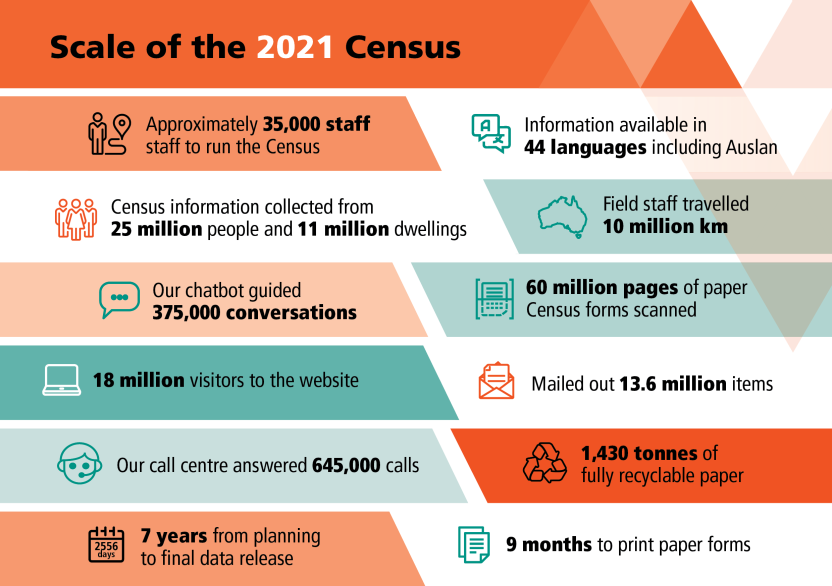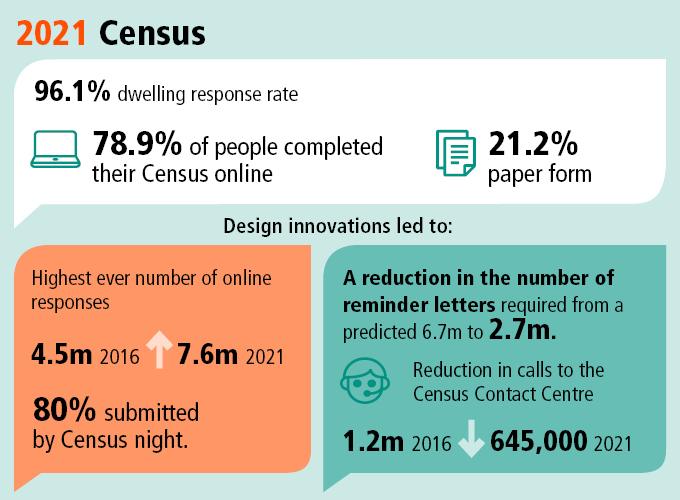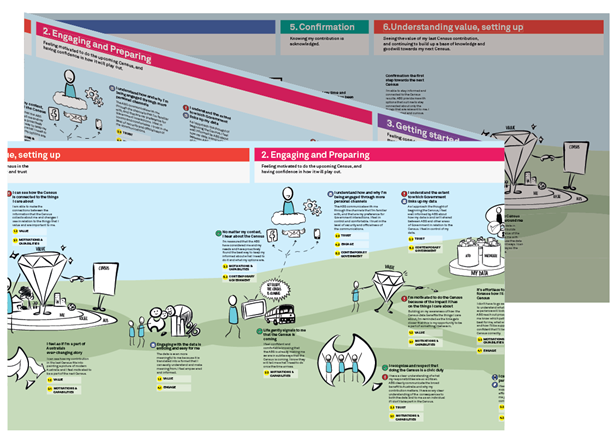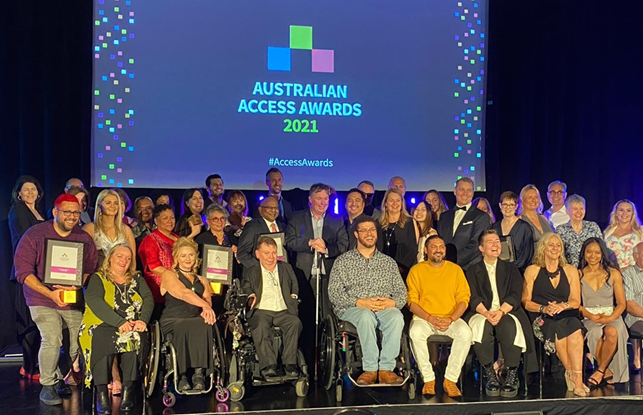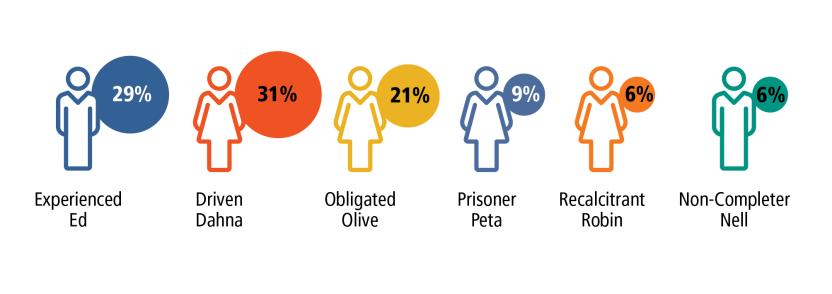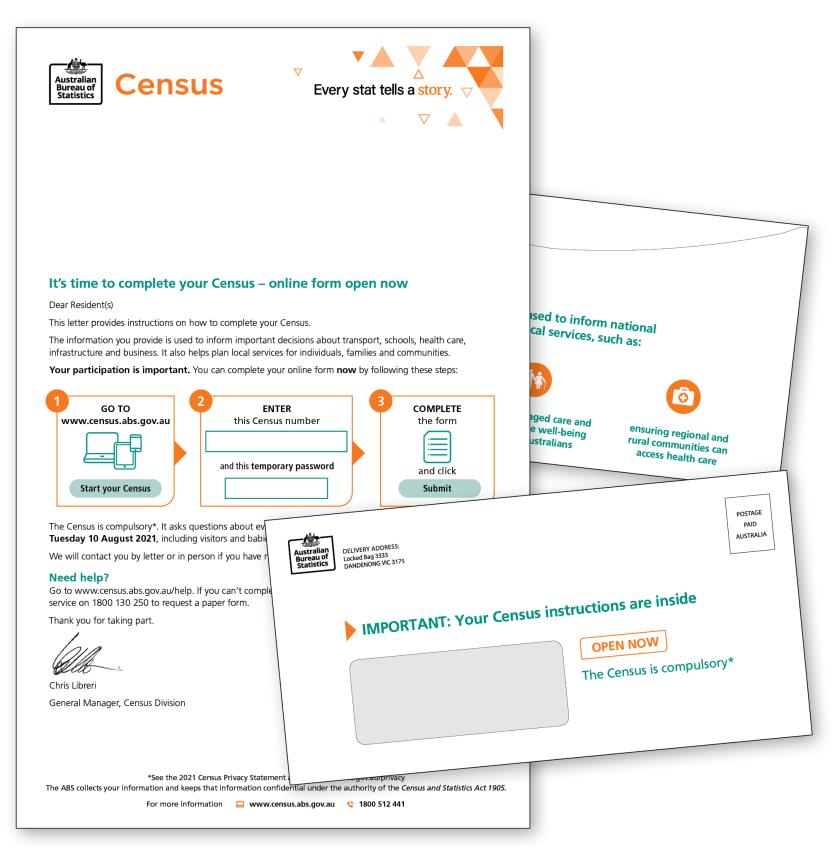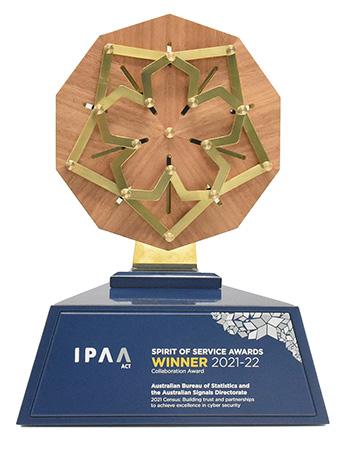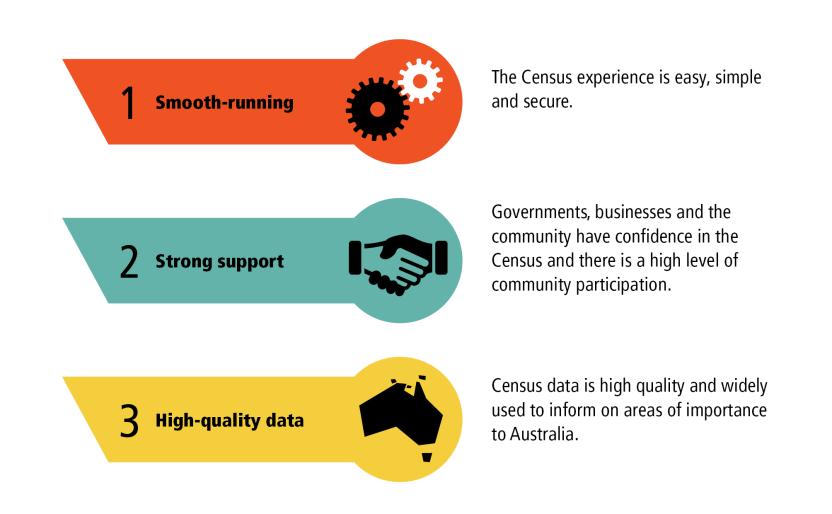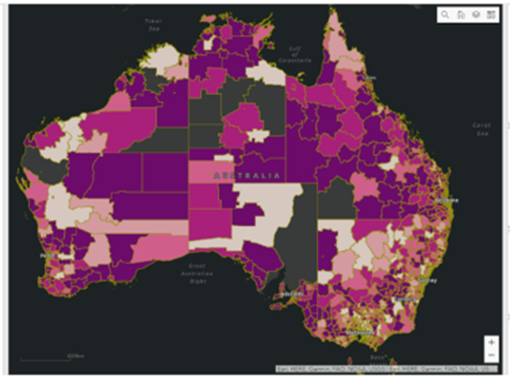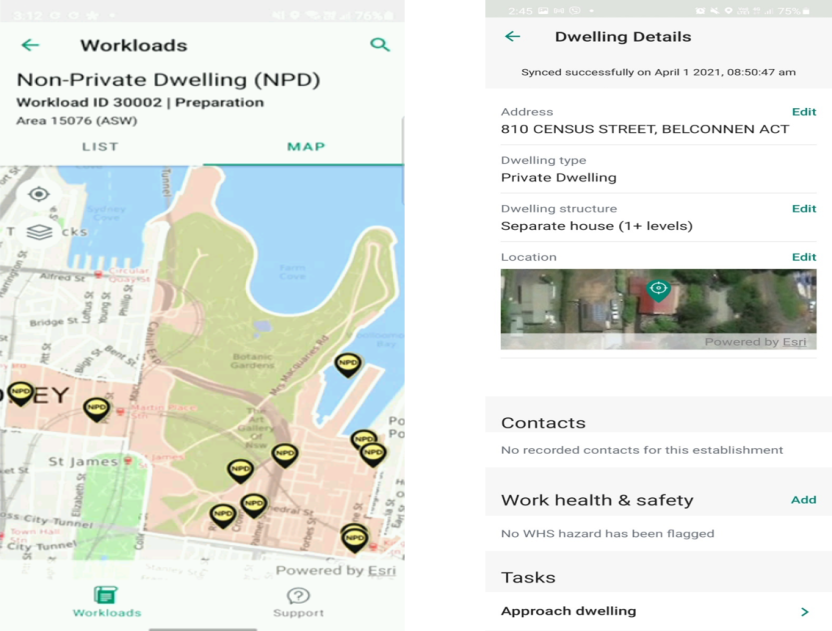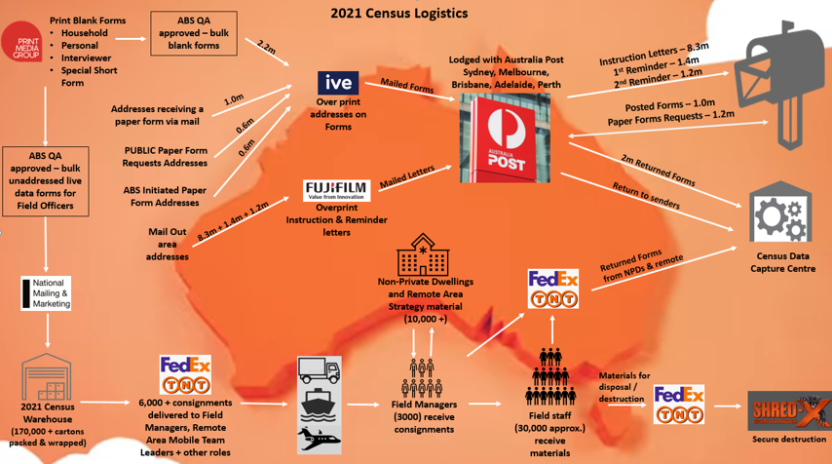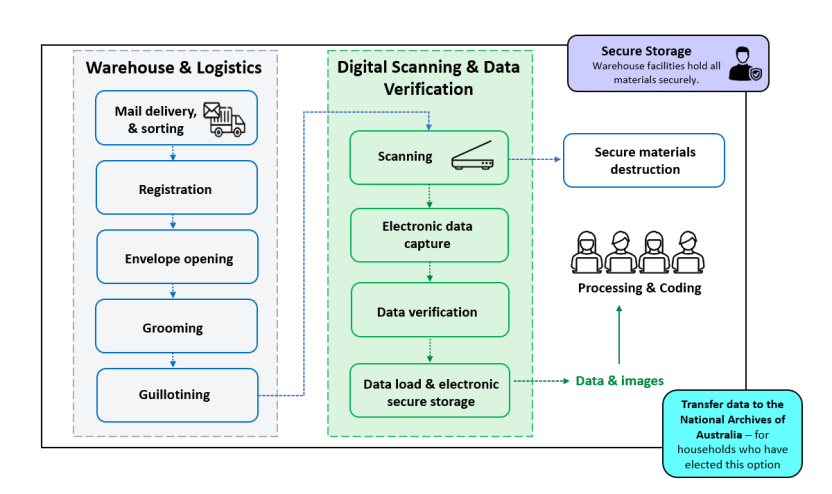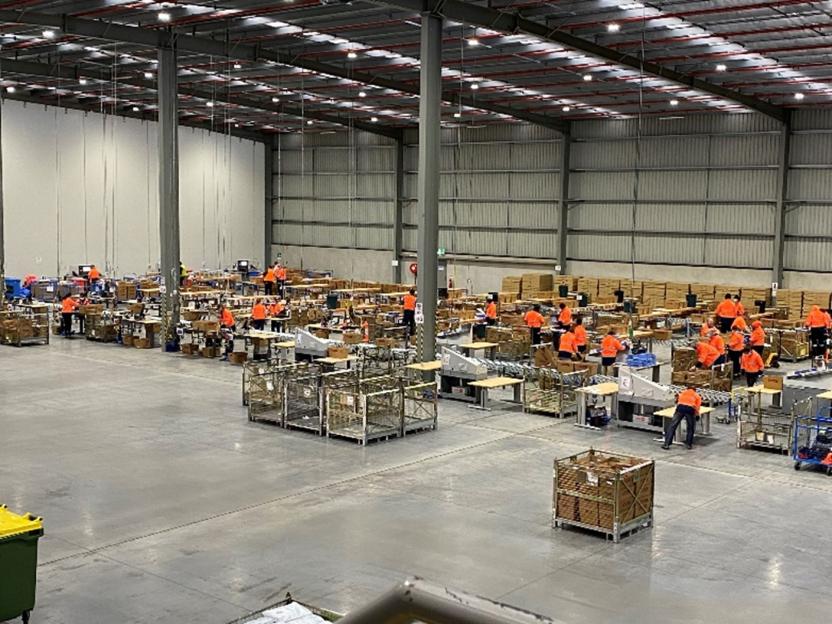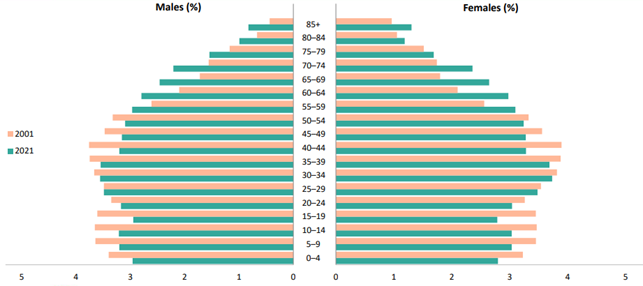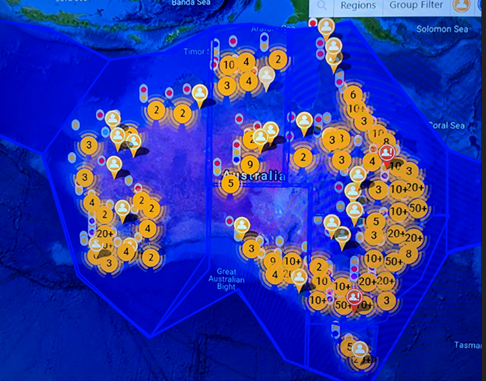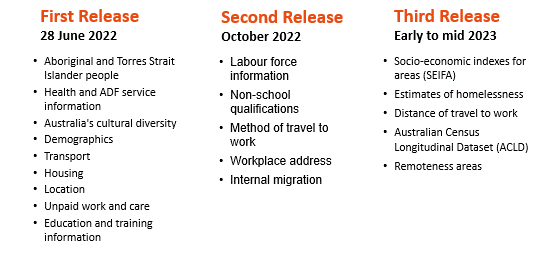The ABS is required by law to run a Census every five years. Governments and organisations use the information we collect to shape our country’s services and infrastructure, such as health, education and transport services. The Census also allows us to understand the cultural, economic and social diversity of our communities. It gives us information about the population across large and small geographic areas.
The 2021 Census counted 25.4 million respondents. This is an increase of over two million people or 8.6% since the 2016 Census.
The ABS had three key objectives for the 2021 Census, to:
- have it run smoothly
- see it well supported by the community and stakeholders
- produce high-quality data.
To run the Census smoothly we had to ensure that completing the Census was quick, easy and secure. Most people found it easy to complete.
Our second objective was to make sure governments, businesses and the community had confidence to strongly support the Census and deliver a high level of community participation. To achieve this objective, we used sophisticated communication and engagement strategies and drew on expert assistance.
Our third objective was to produce high-quality data. The data was quality assured throughout all Census processes. The Census Statistical Independent Assurance Panel concluded the data was fit-for-purpose and of comparable quality to the 2011 and 2016 Censuses and can be used with confidence. At 96.1% the response rate to the Census exceeded our target response rate of 95%, and delivered high-quality data.
The 2021 Census cost just over $565 million. At just over $22 per person counted this is as cost efficient as any previous Australian Census and other countries that run a similar Census model.
An independent report, published in August 2019 by Lateral Economics found the benefits of the Census substantially outweigh its cost. The report found that for every $1 invested in the Census, $6 of value is generated to the Australian economy. For more detail see Value of the Census.
The ABS stories of the 2021 Census
Our advertising campaign showcased the idea that ‘every stat tells a story’. Storytelling is such a critical part of our multicultural society, our history and our future. The power of storytelling has inspired this report, which brings to life many stories of innovation, positive user experience and adaptability from the 2021 Census.
Focussing on customer experience
The 2021 Census took a user-centred design approach for all our interactions with the public. Research, development, and testing of how the public would interact with the Census moved us towards new ways of thinking. We truly adapted to our respondents’ needs and addressed many barriers they had to completing the Census.
Respondents were able to complete the Census through their preferred channel and easily obtain support.
The 2021 Census was our most accessible to date for people with disabilities and it aligned with modern expectations and standards. This was recognised when we won ‘Government Website of the Year’ at the 2021 Australian Access Awards.
Read more from Focussing on customer experience.
Communicating trust and value
The communication campaign for the 2021 Census built on a long history of trust and participation from the Australian public.
Research informing the campaign drew attention to a need for greater and earlier focus on educating the Australian public about the value of the Census. We wanted people to see the Census as more than an obligation. Instead, we wanted people to form an emotional connection to the Census to encourage participation.
The 2021 campaign was based on the idea that the Census isn’t just numbers, but what those numbers tell us – Every stat tells a story. The campaign featured stories about how Census data benefits local communities and organisations. The campaign was adapted for Aboriginal and Torres Strait Islander peoples and multicultural audiences. External research evaluating the campaign’s impact showed a positive shift in attitudes about the value of the Census.
Read more from Communicating trust and value.
An inclusive Census
While the Australian population is very supportive of the Census, we acknowledge there continues to be parts of the country and some smaller population groups that we find harder to reach and motivate to complete the Census. The Census count is crucial particularly for areas of disadvantage where services are needed most, e.g. very remote areas.
Support was available for population groups that needed help to complete their Census. These groups included Aboriginal and Torres Strait Islander people, culturally and linguistically diverse (CALD) communities, people experiencing homelessness and people needing face-to-face support.
Special strategies to ensure an inclusive and accessible Census included tailored communication and targeted engagement, such as providing multilingual staff where needed. We introduced more than 300 pop-up hubs across the country to provide accessible, face-to-face support to members of the public.
Read more from An inclusive Census.
Security and privacy by design
Many recommendations from the multiple 2016 Census reviews focused on security and privacy for the Australian public. The cyber landscape is constantly becoming more complex and it is vital that our methods and systems for maintaining security keep pace with the evolving challenges and threats. We utilised cyber security expertise across government, including the Australian Cyber Security Centre and the Digital Transformation Agency in addition to working with the private sector. We aimed to ensure the highest protection, testing and monitoring activities were undertaken for the Census Digital Service and other Census IT systems.
There have been no service interruptions or major security incidents so far during both the Collection and Processing phases of the Census.
Privacy was a high priority at all stages of developing and delivering the 2021 Census. The 2021 Census Privacy Statement provided assurance to the Australian public their personal privacy was protected when responding to Census questions. The statement detailed what we use personal information for, and how we keep names and addresses secure and separate from one another, and when we delete personal information that is no longer needed.
In addition to the statement, two Privacy Impact Assessments were conducted. The first looked into the privacy settings of the Census overall, and the second assessed the use of administrative data. We published both assessments on our website in July 2020.
Read more from Security and privacy by design.
Into the cloud
The 2021 Census was our first major journey into cloud-hosted systems. We partnered with PwC Australia and Amazon Web Services to develop the Census Digital Service. This included the Census website, the online form and numerous self-service forms on the Amazon cloud platform.
Working with Amazon Web Services, the ABS also built a cloud-based data lake (or data warehouse) containing all Census operations data.
The Census used more than 10 other cloud-based services. These services showed us that cloud architectures are highly scalable and secure when well designed. Partnering with specialists proved invaluable to supplement the ABS’s growing expertise in cloud technologies.
Read more from Into the cloud.
Ensuring relevant and high-quality data
Data quality is a strong focus of every Census. We review questions before each Census to ensure they are still relevant and valuable for Australia.
We conducted an extensive consultation process in 2018 for new topics on the Census form. New questions on the form were added about long-term health conditions and service with the Australian Defence Force. This was the first significant change to questions collected in the Census since 2006.
The success of the 2021 Census was supported by a rigorous quality assurance process involving ABS quality gates. The 2021 Census quality gates have been a critical control for managing Census risks. They ensured all projects were reviewed against an established set of standards before go-live.
Read more from Ensuring relevant and high-quality data.
Excellence in planning and governance
Contemporary governance techniques ensured the program was well run and delivered on time.
Independent assurance is an important element of knowing the Census is ready and the data can be used with confidence. For the 2021 Census this included:
- an assurance provider for the entire Census
- independent Census governance board members
- an independent assurance panel to thoroughly review the quality of the Census data.
Risk and issues management was an important focus. We were well prepared for a wide range of potential scenarios and were confident we could quickly adapt to any unexpected issues in real time. We monitored the external environment to identify any factors that might increase risk to the program. With the many changes caused by COVID-19, our risk management approach served us well. There were no major incidents throughout the Census.
Read more from Excellence in planning and governance.
Monitoring operations during the Census
The 2016 Census was the first time we could see real-time response rates across all areas and population types.
In 2021, we built on this capability with the Operations Insights project. This involved combining all operational and management data from all sources into a single, cloud-based data lake. More than 100 reports were created from the data lake, providing real-time tables, graphs and maps to support decisions.
The reports enabled us to design pre-emptive and responsive actions to mitigate risk during Census collection. They helped us to respond in areas where we had lower than expected field staff recruitment or response rates, often a direct effect of the pandemic.
Read more from Monitoring operations during the Census.
Innovations in the field
We centralised management of our 33,000-strong field workforce for the 2021 Census. This helped us make efficient and consistent decisions, communicate effectively and have specialised teams in place to deal with issues.
We provided our temporary field staff with several mobile applications (apps) they could install and operate on their personal device.
In the lead up to the Census, virtual training was planned for only some parts of the country. However, given increasing pandemic restrictions, the vast majority of field staff were trained virtually.
Read more from Innovations in the field.
Materials and logistics
Producing Census forms and other materials, and delivering them across the country is a massive task requiring the assistance of many vendors. For the 2021 Census, more than 10 million forms and letters were delivered to dwellings across the country, either by Australia Post or Census field staff.
While every Census is a large and complex logistical exercise, more than ever vendors needed to be agile and communicate effectively due to the pandemic.
Read more from Materials and logistics.
Processing the data
As the ABS receives Census forms, either online or on paper, the next process is to turn the responses into statistics to inform critical decision making across Australia. This process takes several months, significant resources and technical expertise.
A temporary facility (warehouse/office) was established in Dandenong, Victoria to receive and process the paper forms.
We need to turn the answers to our 64 questions into 500 variables that are released as statistics. With over one billion Census questions responded to, we rely heavily on automation to classify or code the information. Every Census we aim to improve efficiency of our processes while maintaining the highest quality.
Read more from Processing the data.
Health, safety and wellbeing of staff
Looking after the health, safety and wellbeing of the 35,000 Census staff across Australia was a high priority.
Recognising the need to increase support for our staff, we developed a Wellbeing Framework that identified six priority areas: mental health, work, relationships, environment, physical health, and workplace culture. Specific and measurable actions were taken in each area.
We trained field staff in COVID safe practices, incident and hazard management and provided them with a mobile app to monitor and manage their safety when working outside their homes.
Read more from Health, safety and wellbeing of staff.
Delivering a successful Census during a pandemic
The health and safety of the community during Census Collection was also important. A Census COVID-19 safe plan was developed and tested in late 2020 during an operational readiness exercise involving 100,000 households. This dress rehearsal allowed us to test a mail-only approach, a contactless approach and our ability to quickly change field staff procedures.
When almost half of the population was in lockdown in August 2021, our preparations enabled us to adapt to logistical and operational challenges confidently.
Read more from Delivering a successful Census during a pandemic.
The 2021 Census data
The first tranche of results of the 2021 Census released 28 June 2022, reveal we are a fast changing, growing and culturally diverse nation. For a comprehensive overview of the first release see Snapshot of Australia, 2021.
Read more from The 2021 Census data.



